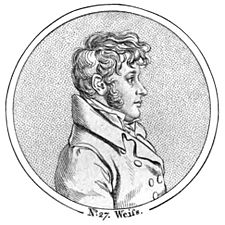Christian Samuel Weiss facts for kids
Quick facts for kids
Christian Samuel Weiss
|
|
|---|---|
 |
|
| Born | 26 February 1780 |
| Died | 1 October 1856 (aged 58) Cheb, Czech Republic
|
| Alma mater | Leipzig University |
| Scientific career | |
| Fields | Physics Mineralogy Mathematics |
| Doctoral advisor | Abraham Gottlob Werner |
| Notable students | Gustav Rose Franz Ernst Neumann |
Christian Samuel Weiss (born February 26, 1780 – died October 1, 1856) was an important German scientist. He was a mineralogist, which means he studied minerals and their properties. He also worked in physics and mathematics.
Weiss is best known for his big contributions to crystallography. This is the study of how crystals are formed and their shapes. He helped turn crystallography into a more scientific and mathematical field.
Contents
Who Was Christian Samuel Weiss?
Early Life and Studies
Christian Samuel Weiss was born in Leipzig, Germany. He was born on February 26, 1780. He went to Leipzig University to study. There, he learned from famous scientists like Abraham Gottlob Werner.
A Career in Science
After finishing his studies, Weiss started teaching physics in Leipzig. This was from 1803 to 1808. During these years, he also traveled a lot. He studied mountain formations in places like Tyrol, Switzerland, and France. These trips helped him learn more about geology.
In 1810, Weiss became a professor. He taught mineralogy at the University of Berlin. This was a very important job. He even served as the university's rector twice. A rector is like the head or principal of a university. He passed away near Cheb in Bohemia.
Understanding Crystals: Weiss's Big Ideas
Christian Samuel Weiss made huge steps in understanding crystals. He helped create the rules for modern crystallography. He showed how important it was to use math to study crystals.
What is Crystallography?
Crystallography is the science that looks at crystals. It studies their shapes, how they grow, and their inner structure. Crystals are found everywhere, from salt and sugar to precious gems.
The Importance of Direction
Weiss taught that the direction of a crystal's faces was very important. He believed that imaginary lines, called crystallographic axes, could help classify crystals. These axes are like invisible guides that show a crystal's structure.
Grouping Crystals: Crystal Systems
One of his most important ideas was creating a way to group crystals. He introduced the idea of crystal systems. This means crystals can be put into different groups based on their unique shapes and symmetry. This made it much easier for scientists to study and understand them.
The Weiss Zone Law
Weiss also has a basic rule of crystallography named after him. It's called the "Weiss zone law." This law helps explain how the different faces of a crystal are arranged. It's a fundamental rule that crystallographers still use today.

Legacy
Christian Samuel Weiss's work changed how scientists studied crystals. He helped make crystallography a true branch of mathematical science. His ideas are still used today by scientists who study minerals and materials.

